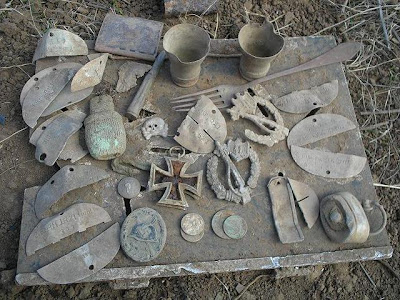VKSVG e.V. contra el comercio de las placas de identificación.
Uno de los principales problemas que se enfrenta actualmente la VKSVG es la proliferación de grupos, sobre todo en la Europa del este, que se dedican al saqueo de las tumbas de los soldados alemanes caídos en la contienda. Uno de los objetos que más interesa al VKSVG son las placas de identificación, que son vendidas por los portales de subastas como ebay sin ningún tipo de escrúpulos.
Estas placas de aluminio o zinc identificaban a cada uno de los soldados alemanes y su robo imposibilita la labor de estos investigadores. Pero no queda ahí el asunto pues también roban cualquier otro vestigio y terminan por desparramar los restos de estos hombres en una muestra total de inhumanidad.
El saqueo de tumbas de guerra es un delito según el Tratado de Ginebra pero parece ser que muchos gobiernos hacen oídos sordos a estos sucesos. La mayoría de las placas terminan en EE.UU. La inmensa cantidad de soldados alemanes caídos en Rusia ha generado un verdadero y macabro negocio del saqueo de tumbas, muchas placas de los caídos en Stalingrado han salido a subasta por internet. Es más, en muchos vídeos analizados por el VKSVG se ha podido comprobar como muchos de los restos encontrados han sido destruidos.
El VKSVG se ha puesto en contacto con Ebay para tratar de poner fin a esta macabra subasta por todo el mundo. Se han cancelado un par de subastas desde que el VKSVG se puso en comunicación con Ebay, pero tan solo una semana después las placas volvieron a salir a subasta. El VKSVG espera poder poner fin a este “comercio”.
Fuente:
VKSVG e.V.
English version
One of the main problems currently facing VKSVG is the proliferation of groups, especially in Eastern Europe, engaged in plundering the graves of German soldiers killed in the fighting. One of the objects that are of most interest to VKSVG nameplates, which are sold by the auction sites like ebay without any scruples.
These aluminum or zinc plates identify each of the German soldiers and the theft impossible the work of these researchers. But the matter does not stop there because also steal any other track and end up spilling the remains of these men in a total sample of inhumanity.
The looting of graves of war is a crime under the Geneva Convention but it seems that many governments turn a blind eye to these events. Most of the end plates in the U.S. The vast number of German soldiers killed in Russia has created a truly ghoulish grave robbing business, many plates of those killed in Stalingrad have come to auction online. Indeed, in many videos analyzed by VKSVG has been verified as many of the remains found have been destroyed.
The VKSVG has already contacted Ebay to try to end this macabre auction worldwide. It has canceled a couple of auctions since VKSVG got in touch with Ebay, but only one week after they came out plates at auction. The VKSVG hopes to end this "trade".
Source:
VKSVG e.V.


































